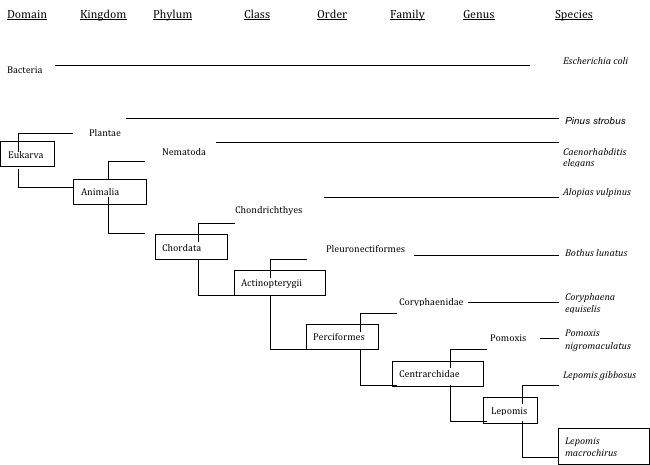Navigation
Finding a Place to Fit In
Domain: Eukarya
As a member of the Eukarya, the bluegill has an endomembrane
system with a nucleus, multiple chromosomes, and large, complex
ribosomes.
Kingdom: Animalia
As a member of Animalia, the bluegill is multicellular,
heterotrophic, and mobile without a cell wall.
Phylum: Chordata
Along with all Chordates, the bluegill, at some point in
development, has a notochord, a dorsal, hollow nerve cord,
pharyngeal gill slits, a post-anal tail, and a thyroid gland.
Interestingly enough, this phylum includes humans!
Order: Perciformes
The Perciformes contain one spine within their pelvic fin.
This order also has some combination of ctenoid and cycloid
scales.
Family: Centrarchidae
Members of Centrarchidae all belong to an informal group that most
know as sunfish. The species within this family have three
or more anal spines. In addition, males in most species
create nests for females to lay eggs.
Genus: Lepomis
The members of Lepomis contain deep bodies, small
mouths, and dorsal fins that are joined together.
Species: Lepomis macrochirus
In Greek, Lepomis means "scaled gill cover" and
macrochirus translates to "large hand"
(Rooke, 1999). A defining
characteristic is a blue spot on each gill. This
characteristic gives rise to "bluegill" as a common name!
If you would like to find out the classification of other organisms,
please visit:
http://animaldiversity.ummz.umich.edu/site/index.html
Phylogenetic Tree (broad in scope)

This phylogenetic tree is based on morphological characteristics. However, other components may be involved in some levels of classification. It is important to remember that this is just one way to classify bluegills. The diagram gets more exclusive in a step-wise fashion from left to right. It does not include all recognized taxonomic groups.
Phylogenetic Tree (narrow in scope)
This phylogenetic tree is based on genetic data from three sources. The species represented in this tree are all from the genus Lepomis. Thomas Near, Daniel Bolnich, and Peter Walnwright created this tree after analysis of mtDNA protein coding gene (NADH subunit 2), a nuclear DNA protein-coding region (Tmo-4c4), and a nuclear DNA intron (S7 ribosomal protein intron 1). Basically, this is a hypothesized phylogenetic tree of species closely related to Lepomis macrochirus. This complex tree passes a series of genetic tests that took years to complete.

